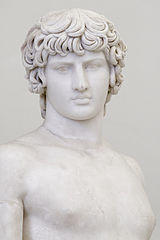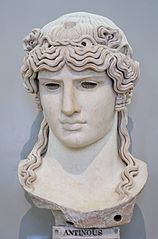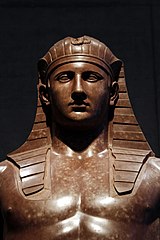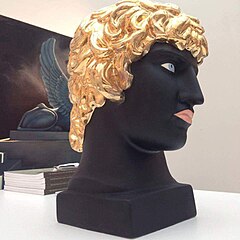269:
209:
193:
252:
29:
284:
228:, the Egyptianizing style, and the Haupttypus style. The Haupttypus style is also known as the main or original style because it is the most popular style of Antinous sculpture. The Farnese sculpture falls within the Haupttypus style. Within the Haupttypus style there are two variations, the first Haupttypus variation depicts Antinous with a curl over his brow, and the other does without it.
182:
formed with a drilling techniques that allowed the Romans to explore texture differences in the hair versus skin in ways that had not been possible before. Another indication that this sculpture is Roman, not Greek, is the inclusion of a structural support on the back right leg, casually disguised as a log. This structural support, also known as a
244:
and
Hadrian. Despite the large quantity of Antinous statues available for viewing, art historians do not actually know what Antinous looks like because of how heavily he is idealized in his portraits. It was expected that Antinous be sculpted as a deity rather than a man, and by conforming to those
181:
can be identified as a Roman imperial piece rather than Greek
Classical by noting the engraved pupils, which was a trend set in Roman sculpture by Hadrian himself. Other Hadrianic-Imperial details of this statue can be seen in the volume of the hair and carved out nostrils, as these features were
236:
that can be used to identify him. The iconography of
Antinous' appearance is so steady across mediums that portraits of Antinous on coins were used in attributing this sculpture as himself. This uniformity, particularly in the uniform layout of his curled locks, implies this portrait was made en
132:
Upon
Antinous's death in 130 CE, Hadrian sought to revitalize Classical Greek sculpture tradition with Roman subject matter. Hadrian's appreciation for Greek art and culture is known as philhellenism, and that love for all things Greek awarded him the nickname "The Greekling." Within Hadrian's
231:
By sculpting
Antinous with consistent conventions artists could delineate Antinous from other Greek mythological figures. The body and face of this sculpture are in idealized youth, with plump cheeks and round face, and his hair is usually unkempt. Antinous's hair has also been described as
120:
before his twentieth birthday in 130 CE. The circumstances of
Antinous's death vary by account, though the most popular theories range from accidental, to suicide, and even those that are sacrificial in nature. In honor of his lover, Hadrian established the city of
85:; the emperor who, after Antinous's death, perpetuated the image of Antinous as a Roman god within the Roman empire. This sculpture is a part of the Roman Imperial style and was sculpted during a revival of Greek culture, initiated by Hadrian's
170:. The most discernible difference between the two is that Antinous is an adolescent youth, while Doryphorus is sculpted as a young adult. Similarities between Antinous and Doryphorus can be drawn with the nude form, use of
232:
artificial looking, even wig-like, because of how similar the placement of his hair is across statues. His youthful appearance, large eyes, pouting lips, and layered locks of hair over his forehead are some of the
268:
240:
The extensive deification of
Antinous as a cult figure has made his likeness the third most common recovered portrait type from Classical Antiquity, following portrait recoveries from
882:
313:
The original provenance for this work of art is unknown, however, there are works of art within the
Farnese collection that have some provenance established, such as the
208:
192:
174:, the stoic expression, as well as the outstretched arm. Doryphorus holds a spear, and Antinous appears to hold something himself in his right hand.
133:
lifetime he had visited Greece on three separate occasions, participated in the Greek
Olympics, and founded a Greek city-state alliance known as the
112:
in the second century CE. Often referenced to as
Hadrian's favorite, or more affectionately Hadrian's boyfriend, Antinous was born a slave in
251:
125:
in Egypt the same year Antinous drowned. Hadrian also went on to deify Antinous postmortem by including him as a figure of the
94:
844:
731:
703:
602:
558:
326:
283:
887:
390:
756:
673:
448:
872:
245:
standards, it's unknown whether this marble depiction of him, or any depiction of him, is accurate or not.
877:
348:
325:
in Rome, from which it was taken to Naples to the Royal Borbonic Museum (Reale Museo Borbonico), now the
274:
149:
129:; because of this, sculptures of Antinous were produced in large quantities for cult worship.
89:. Its found spot and provenance are unknown, but this sculpture is currently a part of the
28:
8:
343:
338:
258:
225:
157:
126:
797:
789:
639:
526:
518:
90:
152:. The philhellenic elements of this statue are drawn from its visual style, while the
801:
752:
727:
699:
669:
598:
597:. The Edinburgh Building, Cambridge: Cambridge University Press. pp. 22, 53–79.
554:
530:
444:
382:
63:
781:
631:
510:
353:
314:
307:
81:
that was sculpted between 130 and 137 CE. Antinous was the lover to Roman Emperor
698:. New Jersey : Pearson Prentice Hall: Upper Saddle River. pp. 248–250.
322:
122:
514:
290:
866:
86:
186:, may have helped further identify Antinous within the context of its time.
318:
171:
134:
233:
161:
643:
619:
522:
498:
224:
There are three styles in which Antinous is traditionally depicted: the
815:
793:
321:. It was once displayed at the entrance to the Carracci Gallery in the
166:
214:
Antinous standing in contrapposto, with a support behind his right leg
156:
was sculpted in the Roman period, Antinous emulates an athlete in the
635:
113:
785:
620:"The Acts of the Apostles, Greek cities, and Hadrian's Panhellenion"
241:
105:
78:
237:
masse for artists in the Roman empire to make further copies of.
109:
82:
668:. London: Weidenfeld & Nicolson Limited. pp. 213–218.
183:
160:
Greek style. Specifically, this sculpture is emulated after
117:
772:
Frel, Jiri (1 January 1973). "In the Shadow of Antinous".
329:(a replica was put in place in the Palazzo in the 1970s).
883:
Sculptures in the National Archaeological Museum, Naples
726:. United States: Cambridge University Press. p. 8.
549:
Boardman, John; Griffin, Jasper; Murray, Oswyn (1986).
751:. Oxford: Oxford University Press. pp. 304, 311.
443:. Yale University: Yale University. pp. 237–243.
116:
110 CE and is speculated to have drowned in the river
548:
553:. New York: Oxford University Press. p. 796.
64:https://mannapoli.it/collezione-farnese/#gallery-5
471:. United Kingdom: Portland Press. pp. 42–45.
202:with engraved pupils and signature wig-like hair.
864:
55:Naples National Archaeological Museum, Naples
16:Marble sculptural representation of Antinous
721:
27:
617:
551:The Oxford History of the Classical World
108:was the Greek lover to the Roman emperor
77:is a marble sculptural representation of
693:
383:"Museo Archeologico Nazionale di Napoli"
306:was named after its one-time owners the
746:
696:Roman art : Romulus to Constantine
663:
466:
438:
219:
865:
387:Museo Archeologico Nazionale di Napoli
717:
715:
462:
460:
434:
432:
430:
428:
377:
375:
373:
371:
327:Naples National Archaeological Museum
95:Naples National Archaeological Museum
771:
689:
687:
685:
659:
657:
655:
653:
595:Power and Eroticism in Imperial Rome
592:
588:
586:
584:
582:
580:
578:
576:
574:
572:
570:
544:
542:
540:
496:
492:
490:
488:
486:
484:
482:
480:
478:
426:
424:
422:
420:
418:
416:
414:
412:
410:
408:
148:is a free standing marble sculpture
499:"Antinous, Archaeology and History"
13:
724:Supports in Roman Marble Sculpture
712:
457:
368:
14:
899:
837:
682:
650:
567:
537:
475:
405:
282:
267:
250:
207:
191:
808:
765:
740:
393:from the original on 2021-08-12
624:Journal of Biblical Literature
611:
140:
137:the year of Antinous's death.
1:
359:
297:
503:The Journal of Roman Studies
277:, in the Egyptianizing Style
7:
774:Metropolitan Museum Journal
694:Nancy H., Nancy H. (2009).
349:Statue of Antinous (Delphi)
332:
10:
904:
888:Marble sculptures in Italy
515:10.3815/000000005784016342
100:
747:Jenkyns, Richard (1992).
722:Anguissola, Anna (2018).
664:Lambert, Royston (1984).
618:Nasrallah, Laura (2008).
262:, in the Mondragone Style
59:
51:
43:
35:
26:
21:
469:Roman Imperial Sculpture
593:Vout, Caroline (2007).
497:Vout, Caroline (2005).
439:Kleiner, Diana (1992).
873:Sculptures of Antinous
467:Tiranti, Alec (1961).
845:"Antinous / Antinoos"
220:Identifying Antinous
816:"copies1 - english"
344:Capitoline Antinous
339:Antinous Mondragone
289:Antinous II, 2005,
259:Antinous Mondragone
127:Roman imperial cult
878:Farnese Collection
749:The Legacy of Rome
646:– via JSTOR.
533:– via JSTOR.
275:Antinous As Osiris
91:Farnese Collection
733:978-1-108-41843-0
705:978-0-13-600097-6
604:978-0-521-86739-9
560:978-0-19-280203-3
69:
68:
895:
859:
857:
855:
831:
830:
828:
826:
812:
806:
805:
769:
763:
762:
744:
738:
737:
719:
710:
709:
691:
680:
679:
661:
648:
647:
636:10.2307/25610139
615:
609:
608:
590:
565:
564:
546:
535:
534:
494:
473:
472:
464:
455:
454:
436:
403:
402:
400:
398:
379:
354:Townley Antinous
315:Farnese Hercules
304:Farnese Antinous
286:
271:
254:
226:Mondragone style
211:
200:Farnese Antinous
195:
179:Antinous Farnese
154:Farnese Antinous
74:Antinous Farnese
31:
22:Antinous Farnese
19:
18:
903:
902:
898:
897:
896:
894:
893:
892:
863:
862:
853:
851:
843:
840:
835:
834:
824:
822:
814:
813:
809:
786:10.2307/1512648
770:
766:
759:
745:
741:
734:
720:
713:
706:
692:
683:
676:
666:Beloved and God
662:
651:
616:
612:
605:
591:
568:
561:
547:
538:
495:
476:
465:
458:
451:
441:Roman Sculpture
437:
406:
396:
394:
381:
380:
369:
362:
335:
323:Palazzo Farnese
300:
293:
287:
278:
272:
263:
255:
222:
215:
212:
203:
196:
143:
103:
17:
12:
11:
5:
901:
891:
890:
885:
880:
875:
861:
860:
849:Api.flickr.com
839:
838:External links
836:
833:
832:
807:
764:
757:
739:
732:
711:
704:
681:
674:
649:
630:(3): 533–566.
610:
603:
566:
559:
536:
474:
456:
449:
404:
366:
365:
361:
358:
357:
356:
351:
346:
341:
334:
331:
299:
296:
295:
294:
291:Olga Tobreluts
288:
281:
279:
273:
266:
264:
256:
249:
221:
218:
217:
216:
213:
206:
204:
197:
190:
142:
139:
102:
99:
67:
66:
61:
57:
56:
53:
49:
48:
45:
41:
40:
37:
33:
32:
24:
23:
15:
9:
6:
4:
3:
2:
900:
889:
886:
884:
881:
879:
876:
874:
871:
870:
868:
850:
846:
842:
841:
821:
820:Antinoos.info
817:
811:
803:
799:
795:
791:
787:
783:
779:
775:
768:
760:
758:0-19-821917-2
754:
750:
743:
735:
729:
725:
718:
716:
707:
701:
697:
690:
688:
686:
677:
675:0-297-78045-X
671:
667:
660:
658:
656:
654:
645:
641:
637:
633:
629:
625:
621:
614:
606:
600:
596:
589:
587:
585:
583:
581:
579:
577:
575:
573:
571:
562:
556:
552:
545:
543:
541:
532:
528:
524:
520:
516:
512:
508:
504:
500:
493:
491:
489:
487:
485:
483:
481:
479:
470:
463:
461:
452:
450:0-300-05948-5
446:
442:
435:
433:
431:
429:
427:
425:
423:
421:
419:
417:
415:
413:
411:
409:
392:
388:
384:
378:
376:
374:
372:
367:
364:
355:
352:
350:
347:
345:
342:
340:
337:
336:
330:
328:
324:
320:
316:
311:
309:
305:
292:
285:
280:
276:
270:
265:
261:
260:
253:
248:
247:
246:
243:
238:
235:
229:
227:
210:
205:
201:
194:
189:
188:
187:
185:
180:
175:
173:
169:
168:
163:
159:
155:
151:
147:
138:
136:
130:
128:
124:
119:
115:
111:
107:
98:
96:
92:
88:
87:philhellenism
84:
80:
76:
75:
65:
62:
58:
54:
50:
46:
42:
38:
34:
30:
25:
20:
852:. Retrieved
848:
823:. Retrieved
819:
810:
777:
773:
767:
748:
742:
723:
695:
665:
627:
623:
613:
594:
550:
506:
502:
468:
440:
397:November 26,
395:. Retrieved
386:
363:
319:Farnese Bull
312:
303:
301:
257:
239:
230:
223:
199:
178:
176:
172:contrapposto
165:
153:
150:in the round
145:
144:
135:Panhellenion
131:
123:Antinoopolis
104:
73:
72:
70:
780:: 127–130.
234:iconography
162:Polykleitos
141:Description
867:Categories
360:References
298:Provenance
167:Doryphoros
802:192967990
531:162186547
509:: 80–96.
164:' statue
158:Classical
114:Bithynium
854:17 April
825:17 April
644:25610139
523:20066818
391:Archived
333:See also
317:and the
310:family.
242:Augustus
146:Antinous
106:Antinous
79:Antinous
52:Location
47:Antinous
794:1512648
308:Farnese
110:Hadrian
101:History
93:in the
83:Hadrian
60:Website
44:Subject
800:
792:
755:
730:
702:
672:
642:
601:
557:
529:
521:
447:
39:Marble
36:Medium
798:S2CID
790:JSTOR
640:JSTOR
527:S2CID
519:JSTOR
184:strut
856:2017
827:2017
753:ISBN
728:ISBN
700:ISBN
670:ISBN
599:ISBN
555:ISBN
445:ISBN
399:2021
302:The
198:The
177:The
118:Nile
71:The
782:doi
632:doi
628:127
511:doi
869::
847:.
818:.
796:.
788:.
776:.
714:^
684:^
652:^
638:.
626:.
622:.
569:^
539:^
525:.
517:.
507:95
505:.
501:.
477:^
459:^
407:^
389:.
385:.
370:^
97:.
858:.
829:.
804:.
784::
778:7
761:.
736:.
708:.
678:.
634::
607:.
563:.
513::
453:.
401:.
Text is available under the Creative Commons Attribution-ShareAlike License. Additional terms may apply.





